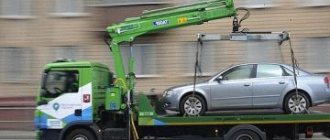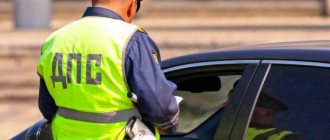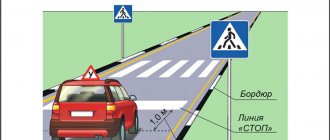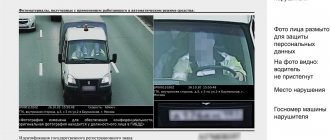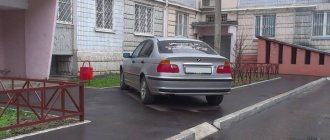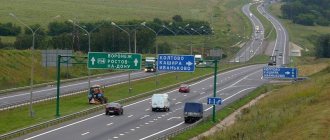Is it possible to pick up a car from an impound lot without paying?
The procedure for returning a vehicle is prescribed in the Administrative Code, Article 27.13. Previously, a car could only be returned by paying off the debt for the impound lot. In the summer of 2021, amendments appeared that give car owners the opportunity to pick up their car from the impound lot immediately and without payment, as soon as the reason for the detention is eliminated.
Attention! If you have any questions, you can chat for free with a lawyer at the bottom of the screen or call Moscow; Saint Petersburg; Free call for all of Russia.
To pay for transportation and parking space in the impound lot, 60 days are given from the date of the decision (not counting the 10 days allotted for appealing the fine).
Normative base
According to the current legislation (Administrative Code of the Russian Federation), the reasons for the detention and evacuation of a car to an impound lot are as follows:
- improper parking: in places, about (clause 2 of Article 12.19), public transport and taxi stops (clause 3.1 of Article 12.19), closer than 5 m from a pedestrian crossing and on the sidewalk (clause 3 of Article 12.19);
- the car interferes with the movement of other vehicles or pedestrians (clause 3.2, clause 4 of Article 12.19);
- the car has malfunctions for which operation is prohibited (clause 2 of article 12.15);
- the vehicle is driven by a citizen who has been deprived of this right by court (Clause 1, Article 12.13);
- the driver is under the influence of psychotropic substances - alcohol, drugs (Article 12.26, paragraph 3 of Article 12.27), including if he refuses to undergo a medical examination (Article 12.26);
- the regulations for the transportation of non-standard cargo were violated: large, dangerous and long (Article 27.13);
- there is no permit for transit transportation (Article 11.26, Article 11.29).
If the motorist manages to eliminate the reason for the detention before the tow truck starts moving, the car is not taken away. Most often this refers to evacuation for illegal parking.
In Moscow, in addition to the Administrative Code, the work of specialized parking lots is regulated by the following documents:
- Moscow DEP order No. 83-TR (08/30/2016) regulates the price for the work of a tow truck and a parking space;
- Moscow Law No. 42 (07/11/2012) and Moscow Government Decree PP-216 (04/09/2012), regulating the rules of loading, unloading and staying in a special parking lot.
Fine in case of car towing
| Why are they being evacuated? | Fine in Moscow and St. Petersburg, r. | In other regions, r. |
| On Pavement | 3000 | 1000 |
| At a public transport stop | 3000 | 1000 |
| Parking at the pedestrian crossing | 3000 | 1000 |
| Second row | 3000 | 1000 |
| In the tunnel | 3000 | 2000 |
| If the car bothers others | 2000 | 2000 |
| On site for disabled people | 5000 | 5000 |
| On the tram tracks | 1500 | 1500 |
How much does it cost to pick up a car from the impound lot?
The amount that the vehicle owner must pay to the impound lot employees includes:
- tow truck operation;
- guarded parking space.
The price increases in proportion to engine power. The Moscow authorities have established the following tariffs:
| TS Group | Cost of transportation to the parking lot | Price per night stay |
| cat.A, B (up to 80 hp) | 3000 | 500 |
| cat.B (80-250 hp) | 5000 | 1000 |
| cat.C (above 250 hp) | 7000 | 2000 |
| cargo vehicle, cat. D | 27000 | 3000 |
The price of impound parking in the constituent entities of the Russian Federation is determined by regional regulations. In some cities, there is an hourly rate for parking a car in a special parking lot; in others, a parking space is provided free of charge for two days from the moment of arrest.
According to Moscow law No. 42 art. 6 clause 2 must be paid every full 24 hours of being in a special parking lot. If the owner manages to present a permit signed by a traffic police officer to return the vehicle on the first day, then he will not have to pay for the parking space.
How much do the services cost?
Prices for tow truck services are presented in the table below:
| City | Motorcycles | Car up to 250 hp | Car over 250 hp |
| Moscow | 3000 | 5000 | 7000 |
| Khabarovsk | 800 | 1000 | 2100 |
| Saint Petersburg | 1300 | 2000 | 3300 |
| Rostov-on-Don | 1000 | 1400 | 1900 |
| Samara | 1000 | 1700 | 2200 |
How should the protocol be filled out?
The powers of traffic police officers include:
- recording an offense;
- making a decision to evacuate;
- drawing up a protocol.
If the driver is present when the vehicle is detained, the protocol is filled out in front of him. The original remains with the inspector, one copy is taken by the violator, and the second by the tow truck driver (if the reason for the detention could not be eliminated). If the driver did not appear while the inspector was filling out the necessary papers, then the document is drawn up in the presence of two witnesses and then transferred to the impound lot. After reviewing the document, the driver signs it.
The protocol contains the date and time of the offense committed and the place where it was recorded. Data indicated:
- about the violator: full name, date of birth (if present);
- about the vehicle: make, model, license plate number;
- about the inspector: full name, title, position;
- about the executor of the evacuation order;
- in fact, the essence of the offense is with points of traffic rules and the Code of Administrative Offenses and penalties.
The motorist has the right to disagree with the offense charged to him. In this case, the protocol is not signed by him, but instead of a signature, a mark of disagreement is placed.
According to the rules for detaining vehicles before evacuation, an inventory of existing external damage, valuables inside the car is drawn up, and the doors and hatch are sealed.
How does evacuation happen?
In order to evacuate the car to the impound lot, the traffic police representative must record the violation in protocol form. If at the time of drawing up the protocol the driver appears at the car, he is asked to eliminate the violation and move the car to the proper place. Compliance with the inspector’s requirements does not eliminate a possible fine or other sanction, however, for minor violations, the driver may be given a verbal reprimand or a written warning.
If a violation is recorded in the protocol, and the driver is not present at the illegal parking site, the following actions are performed:
- a traffic police officer calls representatives of a special agency authorized to forcibly move cars;
- an evacuation report is drawn up - this document records the characteristics of the vehicle, its license plate number, as well as the date and time of evacuation;
- the vehicle is moved using special vehicles, which allows loading and transportation of a stationary vehicle;
- the evacuated car is placed under the impound lot regime - on the site or garage of a special institution, which is included in the regional register.
Special rules apply for temporary storage of cars in impound lots. They are approved by regional authorities and provide a list of responsibilities of the special agency to ensure the safety of the vehicle and prevent damage or unauthorized access by third parties. In addition, the regulations and regulations of the impound lot approve tariffs for the storage and transportation of cars - the calculation of these costs will be presented to the owner when returning the car.
The law does not provide for mandatory notification of the owner about the evacuation. Citizens must take all actions to return the car themselves.
Also on the topic: Repair under MTPL: terms, payments and pitfalls
Step-by-step instructions for returning a car from the impound lot without paying
In the regions there are individual rules for returning a car to the owner. The general procedure for returning a car from an impound lot without paying is as follows:
- Report to the unit that recorded the violation. If the driver was not nearby at the time of arrest, he can clarify all questions by calling the traffic police of his city, the police, or through number 112.
- Provide documents for the car (Vehicle registration certificate, OSAGO policy), your driver’s license and, in some cases, a power of attorney from the owner.
- Receive a copy of the protocol and approval to pick up the vehicle.
- Present all documents to the special parking lot employee.
- Get a pass to leave the territory. Now this is possible without paying a fine. If an employee refuses to issue a pass without receiving a receipt, he is acting illegally.
- Pick up the car.
The fine issued by the inspector and special parking must be paid within 60 days. The fine can be paid with a fifty percent discount if done in the first 20 days. This privilege does not apply to evacuation and special parking.
When the documents are inside the car, the car owner will first have to go to a special parking lot, go to his car with an employee, pick up the papers, and then go to the traffic police. Sometimes inspector work stations are set up at impound lots. This greatly facilitates and speeds up the resolution of the issue; all paperwork for returning the car is received immediately, without unnecessary movements around the city.
Reasons for evacuation
The traffic rules contain several signs and types of markings that prohibit or restrict the parking/stopping of vehicles. These restrictions may apply to all types of transport or provide special rules. For violation of the requirements of road signs and markings, the law provides for punishment - all possible types of sanctions are grouped under the articles of the Special Part of the Code of Administrative Offenses of the Russian Federation.
Let us highlight the key points that need to be taken into account by citizens faced with forced evacuation of a car:
- evacuation consists of forcibly moving the vehicle to specially equipped temporary storage places - the list of such places and special institutions is approved by the regional authorities;
- Evacuation is not included in the administrative sanctions - when returning the car, you only need to pay the costs of transporting and storing the car, and no additional punishment is imposed under the Code of Administrative Offenses of the Russian Federation;
- It is prohibited to evacuate if the car owner is driving or appears at the car at the time the violation is recorded;
- It is not allowed to use administrative evacuation in case of violation of the procedure and terms of use of paid or public parking lots, when these places are officially intended to accommodate cars.
Also on the topic: What happens if the driver is not included in the insurance and gets into an accident?
Identification of cases of improper parking will entail administrative liability. To do this, a traffic police officer or other authorized person must draw up a protocol.
When drawing up a protocol that allows evacuation actions to be carried out, the driver is not on site. Therefore, the contents of the protocol indicate the registration details of the car (its make, model, registration number, etc.). This document will make it possible to bring the violator to justice, and the exact amount of the sanction will be established by a court, other body or official.
Let's highlight the most common violations of parking rules that will lead to forced evacuation:
- violation of the sign “Stopping or parking is prohibited”, including violation of the temporary regime of operation of this sign;
- parking within the boundaries of the pedestrian crossing markings (it is a violation to place a car closer than 5 m from the marking);
- parking at public transport stops or in special lanes for buses, trolleybuses, etc.;
- leaving the car on sidewalks, on lawns and in other places not intended for parking;
- other types of violations.
The use of evacuation is a right, and not an obligation, of traffic police officials. If the car is parked under the influence of a prohibitory sign, but does not interfere with the passage of other vehicles, the inspector may limit himself to drawing up a protocol for the subsequent imposition of a fine. Evacuation is also prohibited if there are passengers (including children) in the car.
What happens if you take a car from an impound lot without permission from the traffic police?
An attempt to seize a car without the knowledge of the inspector is referred to by law as arbitrariness. This is a criminal article (Article 330 of the Criminal Code of the Russian Federation). In this case, an article for abuse of power may be added (Article 286 of the Criminal Code of the Russian Federation). The result of an attempt to illegally take possession of a car from a special parking lot will be a fine of up to 80 thousand rubles, and arrest is possible. In this case, the obligation to pay for the tow truck and parking space will remain with the violator.
The opinion that a car owner has the right not to pay for parking, since he did not ask the traffic police officers to store his car, is erroneous. The procedure for eliminating the violation is clearly stated in the Code of Administrative Offenses, which means paying for the evacuation and presence of the vehicle in the impound lot beyond the free period is an obligation, not a right. It is assigned to the person who committed the offense.
If the vehicle owner believes that the detention had no legal grounds, he will have to go to court to appeal the actions of the traffic police officers. Any attempt to pick up a car without the inspector’s permission will lead to even greater expenses.
Reasons for transporting a car
Cars can be towed to an impound lot for the following reasons:
- the car has a faulty brake system, which poses a threat while driving;
- the vehicle is driven by a person who does not have a driver’s license or has been deprived of one;
- the driver consumed alcohol or drugs;
- the driver violated the requirements established by markings or road signs that prohibit stopping or parking the vehicle;
- improper parking impedes the movement of traffic on the road, or the car was parked at a distance of less than 5 meters from the pedestrian zebra crossing;
- the driver violated traffic regulations regarding the transportation of goods;
- the person driving the car refused to undergo a medical examination to determine the presence of alcohol in the blood;
- the driver used alcohol or drugs after a traffic accident, but before undergoing a medical examination;
This list is closed, i.e. other reasons for evacuation will not be legal.
If the following requirements are met, then evacuation cannot be carried out:
- the tow truck has not yet moved with the vehicle;
- during evacuation there is a person who has the right to drive a vehicle;
- the basis for evacuation has been eliminated or this can be done on site.
It is important to emphasize that recently the lack of a driver’s identification document is not considered a ground for evacuation. Now every traffic police inspector can check the availability of a license using a special database.
If the driver has lost his license or simply forgotten it, he will face a sanction in the form of a fine of 500 rubles . But if a person does not have a certificate, or has been deprived of it, then the services of a tow truck will be legal.
Before carrying out an evacuation, the traffic police inspector must draw up a protocol - always in two copies. The protocol is signed by: the inspector and the motorist.
If the driver refuses to sign the document, the inspector makes a note about this in the protocol. The protocol is drawn up in front of witnesses or recorded on a video camera.
The protocol indicates the following information: time, day, location. The reason for the evacuation must be indicated in accordance with the Administrative Code.
In addition, the full name of the traffic police officer and his position must be written. The document displays information about the vehicle, the driver, as well as the organization that will actually carry out the evacuation and its representative.
If the protocol is drawn up in the presence of the driver, then it is worth asking to note in the document the valuables that are present in the car, as well as to describe in detail all the flaws and breakdowns that the vehicle has.
According to the rules, all entrances to the car must be sealed. If the car owner believes that the evacuation was not carried out legally, he can appeal the decision.
The complaint must be filed in the district court. An appeal against the actions of traffic police inspectors can last up to 90 days.
.
During the trial, the inspector must provide evidence that the motorist committed a traffic offense.
As a rule, traffic police officers use phone photos as evidence, which cannot be a direct means of proof.
In addition to compensation for damages caused, the driver can safely demand compensation for moral damages. If the illegal seizure of a car entails material costs, then the motorist can also request compensation for them.
How to pick up a car from an impound lot without paying for a tow truck?
You can not pay for the tow truck right away in accordance with clause 11 of Art. 27.13 Code of Administrative Offences. Having received permission from the inspector, a resolution and data on the cost of the special parking lot, the car owner has the right to leave the territory. The debt must be repaid within 60 days from the date specified in the resolution. If this is not done, then later the impound lot will collect from the violator through the court everything due: the debt and sanctions for late payment.
There is another way to avoid paying for a tow truck. If the owner eliminated the violation before the tow truck left with the car, then he will not have to pay for its work and pick up the car from the special parking lot. For example, this is possible if parking rules were violated and the owner returned to his car before the car was seized.
How to pick up a car from an impound lot without paying a fine?
The size of the fine and the day of its payment do not affect the return of the vehicle. The main thing here is having the inspector’s permission.
There are several legal options, you can use any at the discretion of the motorist:
- Pay the fine and parking, and then pick up the car.
- Just pay the fine, pick up the car, and pay off the debt for the special parking later.
- Pay only for being in the impound lot (if the free period has ended), and leave the traffic police fine for another time.
- Both the fine and the parking space must be paid within the next 60 days.
If a motorist does not agree with the administrative offense charged against him, within 10 days from the date of the decision, he can visit the traffic police for a detailed consideration of the situation (viewing photos and videos from the place of recording, and so on). During this period, the impound lot does not have the right to detain his car if the inspector allows it to be taken away. Therefore, the presence of fines at the time of returning the car does not matter.
Appealing a fine and evacuation
At the time of making the decision and filling out the protocol, the inspector is obliged to inform the violator of his right to appeal this decision within 10 days.
It is important to remember that the obligation to pay a fine does not depend on the driver’s doubts about the legality of the detention. Therefore, you must pay all the required amounts within the specified period (2 months). In the future, the money will be returned if the evacuation is considered unfounded.
Procedure:
- Collect documents: driver's license, vehicle registration card, compulsory motor liability insurance.
- Find evidence that you are right: video, photo, independent assessment.
- Write an application to the State Traffic Safety Inspectorate, attach documents and evidence to it.
- Wait for an answer. If the answer is no, you can try contacting the Prosecutor's Office. Usually, in cases where the owner of the vehicle is really right, the issue is resolved without prosecutorial checks.
- If the answer is yes, file a lawsuit to cancel the fine and return all the money. In the claim, describe the circumstances, mention the response of the State Traffic Safety Inspectorate and attach it in writing.
Refunds will be made by bank transfer within 28 days from the date the court decision comes into force. They will return both the amount of the fine and the money for the impound lot.

